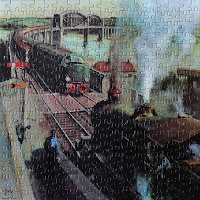Today's post, 5th April 2013, comprises three pictures of jigsaw puzzles replicating the artwork of Terence Cuneo. The trio were made by Arrow, one of the huge manufacturers of the 1960's/70's.
Many of Cuneo's paintings were the result of commissions and his portfolio of subject material was immense. However, he is probably most famous for his railway paintings which are highly sought after by collectors. Several of his paintings were commissioned by the model railway companies Tri-ang and Hornby for use in catalogues, leaflets etc including the three that are pictured below.
 Picture number one shows the first of three 320-piece puzzles from Arrow, this one titled Class 4 Diesel-electric at Saltash (later designated as class 40). This painting was used on the 1963 Triang catalogue. A class 4 diesel- electric locomotive is shown heading a main line express across the famous, single line bridge while a 'Grange' class 4-6-0 steam locomotive waits to cross in the opposite direction.
Picture number one shows the first of three 320-piece puzzles from Arrow, this one titled Class 4 Diesel-electric at Saltash (later designated as class 40). This painting was used on the 1963 Triang catalogue. A class 4 diesel- electric locomotive is shown heading a main line express across the famous, single line bridge while a 'Grange' class 4-6-0 steam locomotive waits to cross in the opposite direction. The second puzzle is titled Night Scene at Crewe. This painting was used on the front of the Triang-Railways - Hornby Dublo leaflet describing their amalgamation in 1965 and again on the Triang Hornby catalogue of the following year. In his book The Railway Paintings of Terence Cuneo the artist titles this painting Voltage versus Steam. Shown in contrast to each other are a small, steam tank locomotive and a class 'AL5' electric locomotive E3077, later re-numbered 85022, heading a speeding express.
The second puzzle is titled Night Scene at Crewe. This painting was used on the front of the Triang-Railways - Hornby Dublo leaflet describing their amalgamation in 1965 and again on the Triang Hornby catalogue of the following year. In his book The Railway Paintings of Terence Cuneo the artist titles this painting Voltage versus Steam. Shown in contrast to each other are a small, steam tank locomotive and a class 'AL5' electric locomotive E3077, later re-numbered 85022, heading a speeding express. The third jigsaw of 320-pieces is titled M7 at Stratford. Arrow was owned by Lines Brothers who also owned Triang Hornby and the jigsaw manufacturer marketed this third puzzle with the other two as a short series or set. Hornby Railways continued to use Cuneo paintings for catalogues, leaflets etc into the 1970's. The small class 'M7' 0-4-4 tank locomotive No.245 is pictured standing outside Stratford Works. This ex Southern Railway locomotive is part of the National Collection in York and was originally built for the London & South Western Railway.
The third jigsaw of 320-pieces is titled M7 at Stratford. Arrow was owned by Lines Brothers who also owned Triang Hornby and the jigsaw manufacturer marketed this third puzzle with the other two as a short series or set. Hornby Railways continued to use Cuneo paintings for catalogues, leaflets etc into the 1970's. The small class 'M7' 0-4-4 tank locomotive No.245 is pictured standing outside Stratford Works. This ex Southern Railway locomotive is part of the National Collection in York and was originally built for the London & South Western Railway.